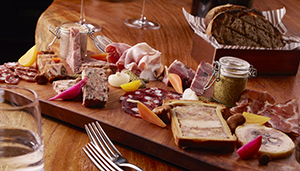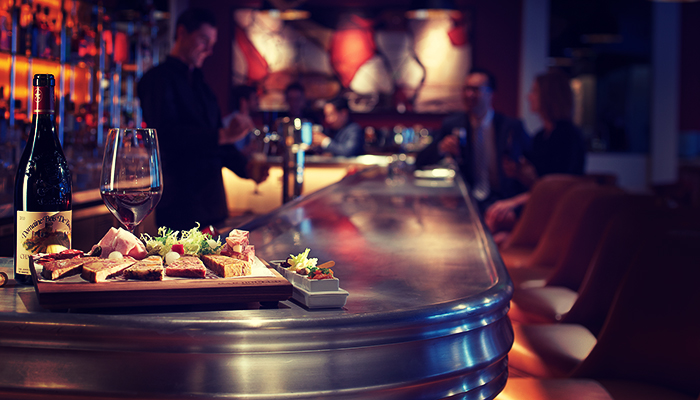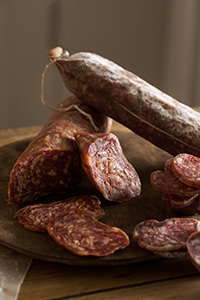
Charcuterie—preserving meats by salting, curing or smoking, as in sausages or pâtés—has been an essential trick of the kitchen since pre-refrigeration days. Though we’ve long since mastered modern preservation methods, the humble charcuterie board has persisted as a shareable favorite, and even become one of the hottest muses in the culinary world. The seminal book on the subject, 2005’s Charcuterie: The Craft of Salting, Smoking, and Curing by Michael Ruhlman and Brian Polcyn, snagged a James Beard Award nomination as it inspired chefs and home cooks alike. Fast-forward a few years, and a spate of charcuterie-driven classes, buffets, butchers, food trucks and restaurants, from such high-profile chefs as Mario Batali (who opened salumi-inspired Chi Spacca in Los Angeles in 2013), have given even more prominence to the course—and diners in cities big and small are eating it up.
“What I’m seeing out there, and I think is great to see, is that older, solid charcuterie items are making their way back on restaurants’ menus,” says chef Ryan McCaskey of Chicago’s buzzed-about Acadia restaurant. “People are making charcuterie like back in the ’70s and ’80s, the classic French way. Instead of reinventing it, it’s nice to see solid, good technique. And at the end of the day, many of the old recipes, styles and techniques just plain taste good.” He cites more intricate terrines as an example of this classic comeback. “People are doing it right. Not just falling back on a country terrine.”
“There is definitely an uptick of interest for Old World-style cured meats,” says David Rule, butcher at Tennessee’s Blackberry Farm inn and restaurant. Though you may find him adding a local Smoky Mountain twist to his charcuterie, Rule is equally passionate about carrying on traditional methods and educating guests. “In our butcher shop, we will continue to produce products with this as our motivation,” he says.
On the flip side, Bar Boulud Boston’s chef charcutier, Tristan Crépin, points out that charcutiers are exploring how to meet new demands from diners. “As consumers become more knowledgeable and health-conscious, I am noticing a shifting trend towards the use of leaner proteins such as poultry, fish and 100 percent vegetable terrines,” Crépin says. “I am also starting to see a lot of experimentation using different ingredients like dried fruits, not typically seen in the traditional French terrine.”
To sample a range of the tastiest charcuterie trends in North America, look no further than these five meat-and-cheese hot spots that offer particularly creative takes from massively talented chefs.
Where: Café Boulud Toronto at Four Seasons Hotel Toronto
What: When it comes to curing, chef Daniel Boulud and team (which includes Parisian charcutier Gilles Verot, who designed the charcuterie programs at this and other Boulud restaurants) set the gold standard. Toronto’s Café Boulud and Dbar offer à la carte charcuterie and cheese boards featuring Canadian products, but for the best experience here, head to Dbar’s charcuterie night every Monday from 5 to 10 p.m. Pair a glass of wine with samples from the large charcuterie display (think pancetta, jambon de Paris and Bayonne, chorizo and saucisson sec, sausages, pâtés and terrines, pickles and grilled bread) and discuss the spread with the charcutier on hand.
Order this: Café Boulud sous chef Sylvain Assié recommends Dbar’s pâté en croûte (a pâté brisée crust with mushrooms, poultry, beef and veal) and the restaurants’ newest additions: seasonal items. “With our new charcutier Thomas Margerie joining the team, after months of training with master charcutier Gilles Verot, we will work on having a new seasonal charcuterie program with seasonal meats such as venison, pigeon and duck,” Assié says.
Where: Acadia
What: Chef Ryan McCaskey’s elegant South Loop restaurant draws Chicagoans with its contemporary take on American cuisine, often inspired by McCaskey’s connection to Maine. (One mainstay on the seasonal menus is Stonington lobster, whether in a roll or Newburg-style.) But Acadia also has become known for its housemade charcuterie, a rotating selection of cuts that has included lomo, chicken liver mousse, wild boar and venison terrines, headcheese, lamb bacon, lamb pancetta, country ham and duck pastrami. You’ll dig into three items at a time, along with inventive but perfectly paired condiments such as apple curry butter, violet mustard and riesling jelly.
Order this:McCaskey’s pick is the bresaola. “It is cured beef eye-of-round that has been rubbed with coffee,” he says. “The flavors are deep, but clean.” He admits to being particularly fond of it because it was a challenging cut to master.
Where: Blackberry Farm
What: This Walland, Tennessee, farm resort, located 45 minutes from Knoxville, is home to both a Forbes Travel Guide Four-Star hotel and a Four-Star restaurant. And one star of the property’s celebrated “foothills cuisine” is butcher David Rule’s charcuterie. Blackberry Farm sources whole animals from local farmers, and what is not used as a fresh cut is cured or dried. Rule is passionate about preserving the culinary history of charcuterie. “As little as two generations ago, my family performed these same curing and preservation techniques before refrigeration as a means for survival. Today we do it as a luxury. It is important that we carry on these traditions and pass them along.”
Order this: Rule enjoys his newest product, guanciale, a dry-cured pork jowl often used in spaghetti alla carbonara. “We have taken a little bit of a Southern American spin to this Italian staple,” he says. “We season with herbs and spices that can be found growing in our gardens here at the farm, and our chefs use it as a base for amazing braised collard greens and pinto beans, and use the rendered fat for cornbread.”
Where: Bar Boulud Boston at Mandarin Oriental, Boston
What: Designed by Gilles Verot and helmed by chef charcutier (and former Verot student) Tristan Crépin, who came to Boston after stints at Bar Boulud’s New York and London locations, the charcuterie program at Daniel Boulud’s newest restaurant aims to create an approachable experience with traditional French charcuterie. Seasonal selections include housemade terrines and pâtés using local ingredients such as chicken liver, pork, duck, beef cheeks, Brussels sprouts, sweet potatoes, olives, cornichons, onions and carrots. Flavors run the gamut from a lamb terrine with Moroccan spices to cured jamón Ibérico.
Order this: Crépin’s favorite menu item is the pâté grand-mère, made with chicken liver, pork and cognac. “It is a classic and the most appreciated pâté in France,” he says. “It pays homage to our mothers and grandmothers, as they are our culinary mentors.”
Where: Ravello at Four Seasons Resort Orlando at Walt Disney World Resort
What: When Four Seasons opened its Orlando resort in the summer of 2014, it brought with it a new standard of luxury for Disney visitors, including elevated dining options. Ravello, the property’s modern Italian restaurant, is a sleek space with an open show kitchen, likely the most sophisticated setting to ever host a Disney character breakfast (twice weekly). Resort executive chef Fabrizio Schenardi, an alum of kitchens at The St. Regis Monarch Beach and the Beverly Wilshire, among others, is a native of Rivoli, Italy, and infuses its flavors into Ravello’s charcuterie. “Almost all restaurants are showcasing charcuterie on their menus,” he says, “obviously relevant to their ethnicity.” Expect Italian options such as prosciutto cotto, prosciutto crudo di Parma and di San Daniele, speck, salame cacciatorino and salame calabrese.
Order this:Though the list of Italian imports is distractingly appealing, be sure to try the meats cured in-house: lonza, duck mortadella, guanciale, porchetta and salame cotto.



